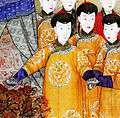Empress Xiaoyichun
| Empress Xiaoyichun | |||||
|---|---|---|---|---|---|
|
| |||||
| Empress Consort of the Qing dynasty | |||||
| Tenure | Empress title granted posthumously | ||||
| Predecessor | The Step Empress | ||||
| Successor | Empress Xiaoshurui | ||||
| Born |
23 October 1727 Jiangsu, China | ||||
| Died | 28 February 1775 (aged 47) | ||||
| Burial |
19 November 1775 Yuling Mausoleum, Eastern Qing tombs, China | ||||
| Spouse | Qianlong Emperor | ||||
| Issue |
Gurun Princess Hejing Yonglu Heshuo Princess Heke Yongyan, Prince Jia Qianlong Emperor's 16th son Yonglin | ||||
| |||||
| Father | Wei Qingtai | ||||
| Empress Xiaoyichun | |||||||
| Chinese name | |||||||
|---|---|---|---|---|---|---|---|
| Traditional Chinese | 孝儀純皇后 | ||||||
| Simplified Chinese | 孝仪纯皇后 | ||||||
| |||||||
| Lady Weigiya | |||||||
| Chinese | 魏佳氏 | ||||||
| |||||||
| Manchu name | |||||||
| Manchu script | ᡥᡳᠶᠣᠣᡧᡠᠩᡤᠠ ᠶᠣᠩᠰᠣᠩᡤᠣ ᠶᠣᠩᡴᡳᠶᠠᡥᠠ ᡥᡡᠸᠠᠩᡥᡝᠣ | ||||||
| Romanization | hiyoošungga yongsonggo yongkiyaha hūwangheo | ||||||
Empress Xiaoyichun (23 October 1727 – 28 February 1775) was an Imperial Noble Consort of the Qianlong Emperor of the Qing dynasty. She was also the mother of the Qianlong Emperor's successor, the Jiaqing Emperor. She was posthumously honoured as an Empress because her son became Emperor, even though she never held the rank of Empress while she was living.
Life
Empress Xiaoyichun was a Han Bannerwoman Bondservant by birth. Her family name was Wei (魏) and her ancestral home was in Jiangsu. Her personal name is unknown. Her father was a Han Banner Bondservant, Wei Qingtai (魏清泰), who served as an interior guanling (內管領) under the Qing government. Her family name was later changed to the Manchu-sounding Weigiya (魏佳) by Qianlong Emperor, and her family including her father was transferred from the Han Baoyi banner to a Manchu banner as was normal for the families of non-Manchu Bannermen or bondservants who became imperial consorts.
Lady Weigiya was originally a lady-in-waiting to the Qianlong Emperor. She became the emperor's concubine in 1745 and was granted the rank of Noble Lady. She was granted the title "Imperial Concubine Ling" (令嬪) on 9 December in the same year, and was subsequently promoted to "Consort Ling" (令妃) on 20 May 1749, and "Noble Consort Ling" (令貴妃) on 4 February 1760. On 28 July 1765. she was granted the title "Imperial Noble Consort Ling" (令皇貴妃), which put her second only to the Empress. The Empress died in 1766 and the Qianlong Emperor did not designate any of his consorts as the new Empress. However, Lady Weigiya, who held the highest rank among all of the Qianlong Emperor's consorts, was placed in charge of the imperial harem and served as a de facto Empress. She accompanied the Qianlong Emperor on his excursions to Mount Tai, Jehol and the areas south of the Yangtze River.
Lady Weigiya died on 28 February 1775 at the age of 47. On 12 March 1775, she was posthumously granted the title "Imperial Noble Consort Lingyi" (令懿皇貴妃), and on 19 November she was interred in the Yuling Mausoleum in the Eastern Qing tombs. On 9 February 1796, the Qianlong Emperor abdicated in favour of his 15th son, Yongyan (Lady Weigiya's son), and became a Retired Emperor or Emperor Emeritus. At the time Qianlong Emperor announced his successor, he posthumously promoted Weigiya to "Empress Xiaoyichun".
Issue
Empress Xiaoyichun bore the Qianlong Emperor four sons and two daughters. Among her children include the Qianlong Emperor's successor, the Jiaqing Emperor.
Empress Xiaoyichun's children were:
- Gurun Princess Hejing (固倫和靜公主; 10 August 1756 – 9 February 1775), the Qianlong Emperor's seventh daughter.
- Yonglu (永璐; 31 August 1757 – 3 May 1760), the Qianlong Emperor's 14th son.
- Heshuo Princess Heke (和碩和恪公主; 17 August 1758 – 14 December 1780), the Qianlong Emperor's ninth daughter, married Zhalantai (札蘭泰) of the Uya (烏雅) clan in September 1772.
- Yongyan (永琰; 13 November 1760 – 2 September 1820), the Qianlong Emperor's 15th son, instated in 1789 as Prince Jia of the First Rank (嘉親王), enthroned on 9 February 1796 as the Jiaqing Emperor.
- Unnamed son (13 January 1763 – 6 May 1765), the Qianlong Emperor's 16th son.
- Yonglin (永璘; 17 June 1766 – 25 April 1820), the Qianlong Emperor's 17th son, made a beile in 1789, promoted to junwang (second-rank prince) under the title "Prince Qing of the Second Rank" in 1799, promoted to qinwang (first-rank prince) in 1820.
Gallery
 In daily dress (with Yongyan)
In daily dress (with Yongyan) In ceremonial dress
In ceremonial dress In ceremonial dress
In ceremonial dress- In court dress
 In court dress
In court dress
Modern references
Empress Xiaoyichun is portrayed by Zhao Lijuan (Juanzi) in the television dramas My Fair Princess (1998-1999) and by Chen Li in My Fair Princess III (2003), based on a novel series by Taiwanese romance writer Chiung Yao. She is referred to as Consort Ling in the dramas.
She is portrayed by Li Chun in the television drama Ruyi's Royal Love in the Palace (2018), and Wu Jinyan in Story of Yanxi Palace (2018).
See also
References
- Rawski, Evelyn S. (1998). The Last Emperors: A Social History of Qing Imperial Institutions (Reprint ed.). University of California Press. ISBN 052092679X.
- Wan, Yi; Shuqing, Wang; Yanzhen, Lu; Scott, Rosemary E. (1988). Daily Life in the Forbidden City: The Qing Dynasty, 1644-1912 (Illustrated ed.). Viking. ISBN 0670811645.
- Zhao, Erxun (1928). Draft History of Qing (Qing Shi Gao) (in Chinese).
| Chinese royalty | ||
|---|---|---|
| Preceded by Ulanara, the Step Empress |
Empress of China (title granted posthumously) |
Succeeded by Empress Xiaoshurui |